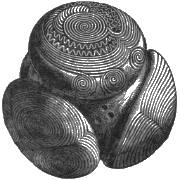NMS Archaeology Object 14530: H.KE 18 - Plaque
Description
Summary
Square bronze plaque with enamelling and with six holes, depicting Christ, from Borve, Benbecula, late 12th or 13th century
Accession Number
H.KE 18
Other references
| Register number | 1977 |
|---|
Original description
T. Deniozou note, 2011-01-28, Information taken from Glenn, Virginia, Romanesque & Gothic: Decorative Metalwork and Ivory Carvings in the Museum of Scotland, NMSE Publishing, Edinburgh, 2003: [One of] B1, C42, 41-2 [Angels, Nobles and Unicorns reference] //Square bronze plaque with enamelling depicting Christ, from Borve Benbecula, with six holes. 6.2 cm x 6.2 cm//A half-length figure of Christ stands in the centre, his head with cruciform halo inclined towards his right hand which is raised in blessing. He wears a belted robe with a cloak draped over his left shoulder, concealing his left arm. His features and the drapery folds are roughly indicated by engraved lines. The background is carved out for champlevé, in large leafy shapes and a horizontal bar behind his head. A plain border of green enamel frames the plaque, further areas of green and blue decorate the background, with some traces of red. The outer edge is pricked with double dotted lines. The reverse of the plaque is completely plain.//There is a round hole, part of the original design, in the centre of each side and two later holes either side of Christ’s head.//Both the drawing and the application of the enamel colours is so crude that it is doubtful if this piece was actually made at Limoges, although it is strongly influenced by prototypes from the French centre.2 It is true, however, that the production of the Limoges ateliers varied from carefully executed, specially commissioned works of art, to religious souvenirs carelessly produced for pilgrims and scholars to offer to parish churches on their return home. Therefore, quality cannot alone dictate either the origin or the date of an enamel of this type.3//Nevertheless, the disproportionately large right arm of this figure, the extremely sketchy engraved lines for features and folds and above all the blockish angular forms of the plants in the background do not seem to fit into the identifiable Limoges oeuvre at all. They are, on the other hand, very close to three plaques of Christ Blessing found in Gotland and south-west Sweden. Many of the drawing characteristics are shared with a circular plaque in Lund,4 while almost identical designs and technical skills appear on two square enamels in the Statens Historiska Museum in Stockholm (fig 15, page 39). It is now believed that these were made in a Scandinavian workshop and it seems very likely that the Borve plaque was imported from that source. These square plaques probably originally decorated the reverse of a large curcifix//NOTES:1 Caldwell 1978, 379-80.//2 Thoby 1953, pls XXII, XXIV.//3 Nilsén 1998, 19.//4 Andersson 1980, fig 99
Associated person/people (e.g. excavator/former collection)
None
Discovery / field collection
Date of discovery
1943
Method (e.g. excavation)
Not recorded
Place (i.e. location of discovery)
Grid reference
Not recorded
Acquisition
Acquisition date
1977
Acquisition source (i.e. name of donor)
Not recorded
Acquisition source role (e.g. donor)
Vendor
Image
Identifiers and Links to Other Records
This record has no links! Would you like to help?
| Identifier / External Link | Linked Record | Status | Comment |
|---|---|---|---|
| NMS Accession Number: H.KE 18 | No linked record | Identifier supplied by NMS |
This area is visible only to logged in users.
